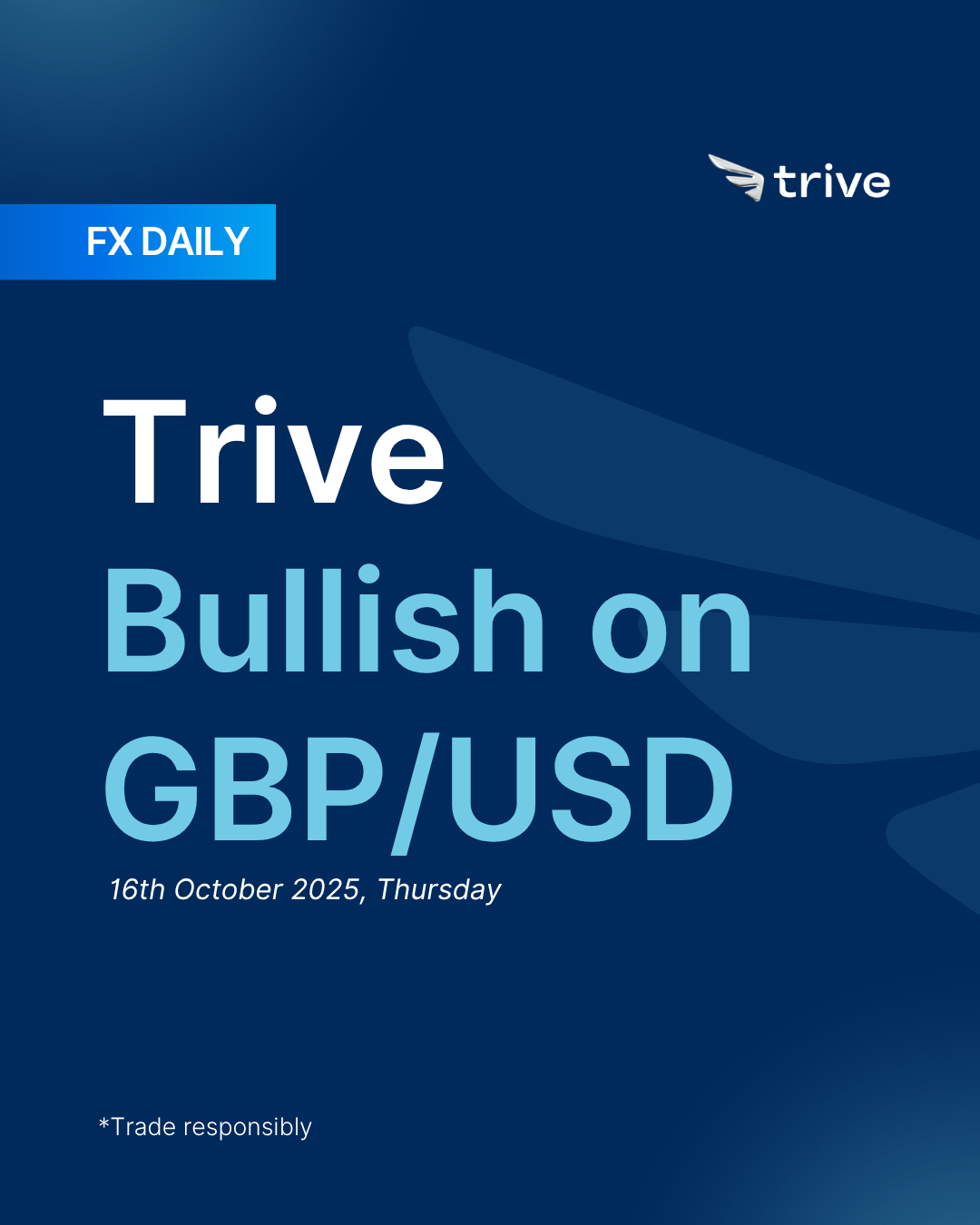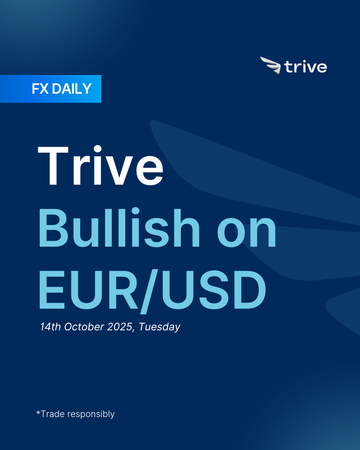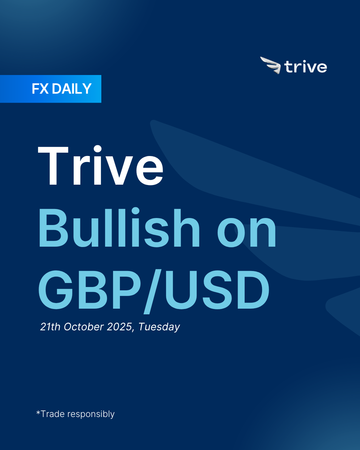FX Daily: Trive Bullish on GBP/USD

The pound recovered after early losses as easing US-China tensions and a weaker USD helped lift sentiment. While UK fiscal worries ahead of the November budget remain a drag, solid wage growth and sticky inflation keep the BoE relatively cautious, limiting downside. With French and US political risks now weighing more on the dollar, GBP/USD has room to rebound. We turn bullish GBP/USD, viewing dips as buying opportunities as long as fiscal headlines don’t worsen and risk sentiment stays steady.
GBP: Short term strength
The British Pound spent the week on the back foot, gradually bleeding lower against a broadly stronger US Dollar as a lack of domestic catalysts left the currency exposed to external forces and growing anxiety over the UK’s fiscal outlook. With no major economic data releases to provide direction, sterling’s narrative was dominated by the looming November 26th Autumn Budget. Reports highlighting a significant budget shortfall and the tough choices facing the Chancellor cast a shadow over the currency. Cable (GBP/USD) consistently drifted lower, breaking below the 1.3400 support level and touching its lowest point since late September, before finding a modest reprieve during the dollar’s sharp sell-off at the end of the week.
At home, the main theme was rising market anxiety ahead of the Autumn Budget. Weekend reports suggested the UK economy might be on weaker footing than previously thought because of revisions in ONS savings data, and attention stayed on the significant GBP 20 to 30 billion budget shortfall that Chancellor Reeves must address. Former Bank of England official Sir Charlie Bean said the government lacks a credible plan for growth and debt reduction. The data backdrop did not help, as the UK S&P Global Construction PMI for September showed a minor uptick but stayed firmly in contraction at 46.2, with residential, commercial, and civil engineering work all continuing to decrease at solid rates, which reinforced the view of a sluggish domestic economy.
On policy, Bank of England policymaker Catherine Mann reiterated her characteristically hawkish stance and argued that policy needed to remain restrictive for longer to squeeze out persistent inflation. Her comments did not provide meaningful support for the pound, as her views are well known and already reflected in market pricing. Despite some hawkish remarks, investors continue to see very little chance of further tightening from the Bank of England, with only a few basis points of loosening priced in by the end of the year.
External forces did most of the steering. Sterling’s path for most of the week largely mirrored the US Dollar’s strength, with losses driven less by UK-specific weakness and more by the dollar’s rally against the Euro and the Yen. Technical factors also played a role, as the break below the key 1.3400 level on Tuesday accelerated selling pressure and pushed the pair toward its September lows, before Friday’s global risk-off move helped it recover some ground.
Sterling slipped over the past week, tracking the broader dollar strength and struggling to find domestic traction as attention turned to the UK’s fiscal challenges ahead of the November 26th Autumn Budget. The pound broke below key technical levels early in the week as reports of a large budget shortfall and weak construction data deepened concerns over the government’s growth credibility. A modest late-week rebound coincided with the dollar’s sharp reversal, but overall sentiment around the currency remains cautious.
Near term, neutral with a mild bearish skew. The main near term drivers are fiscal sentiment and global risk appetite. The UK’s fiscal backdrop has become a headwind, with markets wary of how the Chancellor will address the widening deficit without undermining fragile growth. At the same time, the lack of strong domestic data leaves sterling dependent on external dynamics. We stay broadly neutral but lean slightly bearish unless the dollar softens and UK data surprise to the upside. The tone could turn constructive if Tuesday’s job report shows steady wage growth and if Governor Bailey strikes a confident note about policy discipline, but a weak GDP print or further negative fiscal headlines would likely keep pressure on the pound.
Longer term, weak bearish. The medium-run outlook remains mildly negative as structural constraints, sluggish productivity, and persistent fiscal concerns continue to weigh once the Fed’s easing cycle begins. The near term policy premium helps cushion the downside, but long run fundamentals still argue for a softer sterling profile compared to peers. Domestic resilience in services, wages, and inflation could justify a more balanced view, yet without clear signs of stronger growth or fiscal credibility, rallies are likely to fade.
If the narrative or policy tone shifts materially, for instance, if the government outlines a credible medium term fiscal plan or the BoE signals renewed tightening bias, we will reconsider and lean toward a stronger currency.
USD: Short at rally
The US Dollar experienced a turbulent week, initially climbing to multi-month highs on the back of weakness in other major currencies before dramatically reversing course on Friday following a severe escalation in US and China trade tensions. The DXY index began the week strong, breaking above 99.00 as political turmoil in France and Japan weighed heavily on the Euro and the Yen, respectively. However, this narrative was completely overturned when President Trump threatened “massive tariffs” on China in response to Beijing’s new export controls on rare earths. The threat shattered market confidence, triggering a sharp bout of risk aversion that saw equities plummet and investors dump the dollar in favor of traditional safe havens like the Japanese Yen and the Swiss Franc, sending the DXY tumbling from its peak near 99.56.
The defining event of the week was President Trump’s aggressive response to China’s implementation of export controls on some rare earth materials. He stated that massive tariffs were under consideration and questioned the need for an in-person meeting with Chinese President Xi, which reignited fears of a full-blown trade war and sparked a significant risk-off reaction in global markets. A ceasefire between Israel and Hamas came into effect on Friday, which was a significant geopolitical development that eased tensions in the Middle East, although the positive market impact was completely overshadowed by the escalation between the United States and China.
The minutes from the September FOMC meeting revealed a hawkish tilt among policymakers. Several participants noted that financial conditions might not be particularly restrictive, and a few indicated they could have supported keeping rates unchanged at that meeting. The minutes confirmed that Governor Miran was the only member who dissented in favor of a larger 50 bps cut. Fed officials presented a range of views throughout the week. New York Fed President Williams supported further rate cuts, describing policy as modestly restrictive. In contrast, Governor Barr struck a cautious tone, noting strong third-quarter consumer spending and expressing skepticism about the Fed’s ability to look through tariff-driven inflation. Governor Waller also stated the Fed needs to cut rates, but should do so cautiously and in 25 bps increments.
The ongoing US government shutdown meant a near-total absence of official Tier-1 economic data, which hampered visibility for both the market and the Federal Reserve, with releases for CPI and Retail Sales now expected to be delayed. The preliminary October University of Michigan consumer sentiment survey was a key data point in an otherwise empty week, with the headline sentiment figure edging down slightly to 55.0 from 55.1. One-year inflation expectations eased to 4.6 percent from 4.7 percent, while long-run expectations held steady at 3.7 percent.
The dollar’s initial strength was not driven by positive US developments but rather by significant weakness in its counterparts. The resignation of the French Prime Minister pressured the Euro, while the election of a new LDP leader in Japan, viewed as favoring looser policy, weighed on the Yen. When tariff threats hit on Friday the move triggered a classic flight to safety, yet the dollar was sold instead of acting as a haven. Because the shock originated from US policy, investors preferred the Japanese Yen and the Swiss Franc, which caused a sharp reversal in the greenback’s fortunes and a broad-based selloff in US equities.
No progress was made toward ending the federal government shutdown. The White House confirmed that permanent layoffs of federal workers, described as reductions in force, have begun, which signals a move beyond temporary furloughs and adds another headwind to the domestic outlook.
The dollar spent most of the week on the front foot, underpinned by carry-over from September’s hawkish FOMC, better pre-shutdown data and typically supportive early Q4 seasonality, before reversing sharply on Friday as tariff headlines hit risk appetite. Despite the late drop, it still finished the week a touch firmer on a broad basket.
Near term neutral/weak bearish. The main driver into the new week is global risk sentiment around US-China tariff rhetoric, which overwhelmed otherwise constructive USD supports and can remain dominant even if fundamentals argue the other way, yet it can also flip quickly if the tone improves. Domestically, front end pricing is wobbling in a data vacuum while the market looks to Chair Powell for how the Fed is interpreting the gap and to PPI and Retail Sales for confirmation of momentum. Externally, any escalation that dents global equities and credit tends to channel haven flows toward JPY and CHF rather than the dollar when the shock is US-centric, pressuring the basket. A more hawkish Powell, firmer retail demand or a rebound in short-dated yields would soften this bias toward neutral, while concrete tariff steps or softer prints would extend the drag. Risk sentiment was the key force behind Fridays weakness, it can stay in charge into next week, but such sentiment led swings can reverse abruptly when the tone changes.
If tariff noise fades, equities stabilize and the Fed sounds less willing to validate easing bets, the near term view could flip toward neutral or even weak bullish.
Longer term weak bearish. The medium run still leans toward gradual USD underperformance as growth cools and the Fed resumes cutting once official data flow normalizes, with fiscal uncertainty and twin deficit optics an added headwind. Seasonality remains a tailwind but not a thesis on its own, and relative rate support looks less assured if global central banks ease at a slower pace than currently priced. The shutdown-driven data blackout and the soft private surveys that guided last week’s weak bias remain relevant until a run of stronger official labor and inflation numbers proves otherwise. A sustained rise in front-end yields and a clear pushback from the Fed would lift the stance toward neutral, while broader risk aversion not tied to the US would generate only fleeting USD resilience.
 GBP/USD 4H
GBP/USD 4H
Disclaimer
This material is provided for informational purposes only and does not constitute financial, investment, or other advice. The opinions expressed in this material are those of the author and do not necessarily reflect the views of Trive International. No opinion contained in this material constitutes a recommendation by Trive International or its author regarding any particular investment, transaction, or investment strategy. This material should not be relied upon in making any investment decision.
The information provided does not consider the individual investment objectives, financial situation, or needs of any specific investor. Investors should seek independent financial advice tailored to their individual circumstances before making any investment decisions. Trive International shall not be liable for any loss, damage, or injury arising directly or indirectly from the use of this information or from any action or decision taken as a result of using this material.
Trive International may or may not have a financial interest in the companies or securities mentioned. The value of investments may fluctuate, and investors may not get back the amount they originally invested. Past performance is not indicative of future results.
For more information about Trive International, please visit http://trive.com/int
Additional Information
Investing involves risk, including the potential loss of principal. Diversification and asset allocation strategies do not ensure a profit or guarantee against loss. The content in this material is subject to change without notice and may become outdated or inaccurate over time. Trive International does not undertake any obligation to update the information in this material.
By accessing this material, you acknowledge and agree to the terms of this disclaimer. If you do not agree with these terms, please refrain from using this information.
No comments
Home
Trive
TriveHub





0 comments